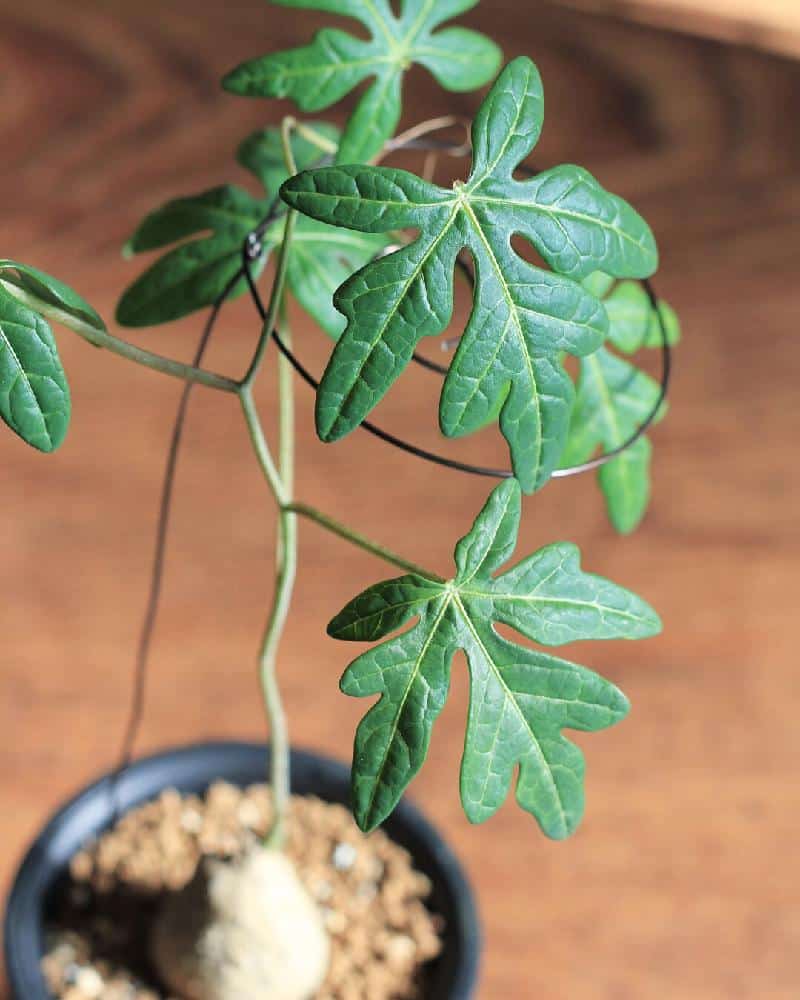Adenia stenodactyla is a herbaceous climbing plant that can grow up to 2.5 m long.
As in other Adenia plants, the rootstock functions as a water store that the plant can use in times of drought.
This plant can be found in Mozambique, Tanzania, and Zambia.
The caudex (basal stem) can measure up to 30 cm in diameter.
These plant branches are quite similar to a vine; they are deep green to grayish-green, which grow in summer and are between 50 to 250 cm long.
The basal parts are more or less woody. And the tendrils are sterile up to 12 cm long, which occur one per leaf or may not present at all.
The leaves have a grayish-green color and sometimes have purplish spots on the underside. The leaves are 2 to 25 cm in diameter.
The inflorescences can have 10 flowers in the females or 1 to 3 flowers in the males.
They have tendrils 2 to 6 cm long and a peduncle 1 to 8 cm long.
The flowers are sometimes reddish with streaks.
The male flowers are broadly tubular, including stems of about 25 to 40 mm long. Petals about 6 to 10 mm long, filaments about 4 to 7.5 mm long.
The female flowers are flared, measuring about 2 to 3 (sometimes 4) mm in height.
When the flowers are hermaphroditic, they resemble male flowers, but with a well-developed pistil (female organ of a flower).
Each inflorescence bears about 1 to 2 fruits, and when it is dry, it is red. Each capsule that the fruits have has 40 to 60 seeds, which are
Seeds: of 40 to 60 per capsule, obovate (egg-shaped), 5 to 6.5 mm long.
You may like: Adenia stylosa
Adenia stenodactyla Care
Follow these steps, and you won’t have any issue with the care of your succulent plant.
Illumination
Adenia stenodactyla can grow quite well in full sun or partial shade.
Something curious about this plant is that the Adenia stenodactyla likes to be in the shade, while the leaves like to be in the sun.
One recommendation is to protect your plant during the sunniest summer hours to prevent the leaves from burning.
Substratum
A very porous substrate is needed; you can add a universal substrate: pumice, vulcanite, and perlite to improve drainage.
If you don’t want to get too complicated with the substrate, you can buy a substrate for cacti and succulents, as they do very well.
Watering
This plant should be watered with some regularity in summer, while in winter, it is best to keep the soil dry as much as possible to prevent the plant from rotting easily.
Also, this beautiful plant does not like to be watered a lot when it has no leaves.
Propagation
The best way to propagate your Adenia stenodactyla is through seeds, since propagation by cuttings is possible, but usually, the plant does not produce a caudex.
If you want the plant to produce seeds, the best way to propagate them is from cuttings since they bloom more freely.
But if you want the plant as decoration, it is best to grow them from seeds, since they develop a caudex.
Pests or diseases
The main problem with adenia is root rot when overwatered.
During spring and summer, keep taking care of your plant to prevent it from getting sick from some very common pests at this time of year.
Temperature
These plants appreciate warm, sunny climates.
They tolerate high temperatures quite well.
The ideal temperature for this plant is approximately 70ºF (21ºC).
If you have your plant in a pot, it is best that you keep your Adenia stenodactyla inside your home during the autumn and winter months, all with the purpose of protecting it from extreme cold.
If the temperature where you live is not lower than 60ºF (15ºC), you can have it outside, while if the temperature is below 44ºF (6ºC), it is best to have it inside.
Fertilization
You can fertilize your plant during the active growing season, that is, during spring and summer.
You only have to apply a specific fertilizer for cacti and succulents once every 2 to 3 weeks.
During the fall and winter, suspend fertilization; at this time, the plant does not need to be fertilized.
What you can do is add some fungicide during the winter (it can even be homemade) to prevent the appearance of fungi.
Transplant
If you have your plant in a pot, it is best to transplant it every two or three years.
If you notice that the roots are coming out of the drainage hole, it is time to transplant.
Make sure that the new pot has a drainage hole; you can also take the opportunity to add some slow-release fertilizer to strengthen your plant.
Toxicity
This plant’s sap is poisonous, so you should handle the plant with caution, especially when pruning or transplanting your adenia stenodactyla.
You should also be careful with thorns, as they can be dangerous.
Pruning
You don’t have to prune Adenia stenodactyla as regularly.
You just have to remove those leaves that are already wilted, to give the plant a more beautiful appearance and maintain its health.
